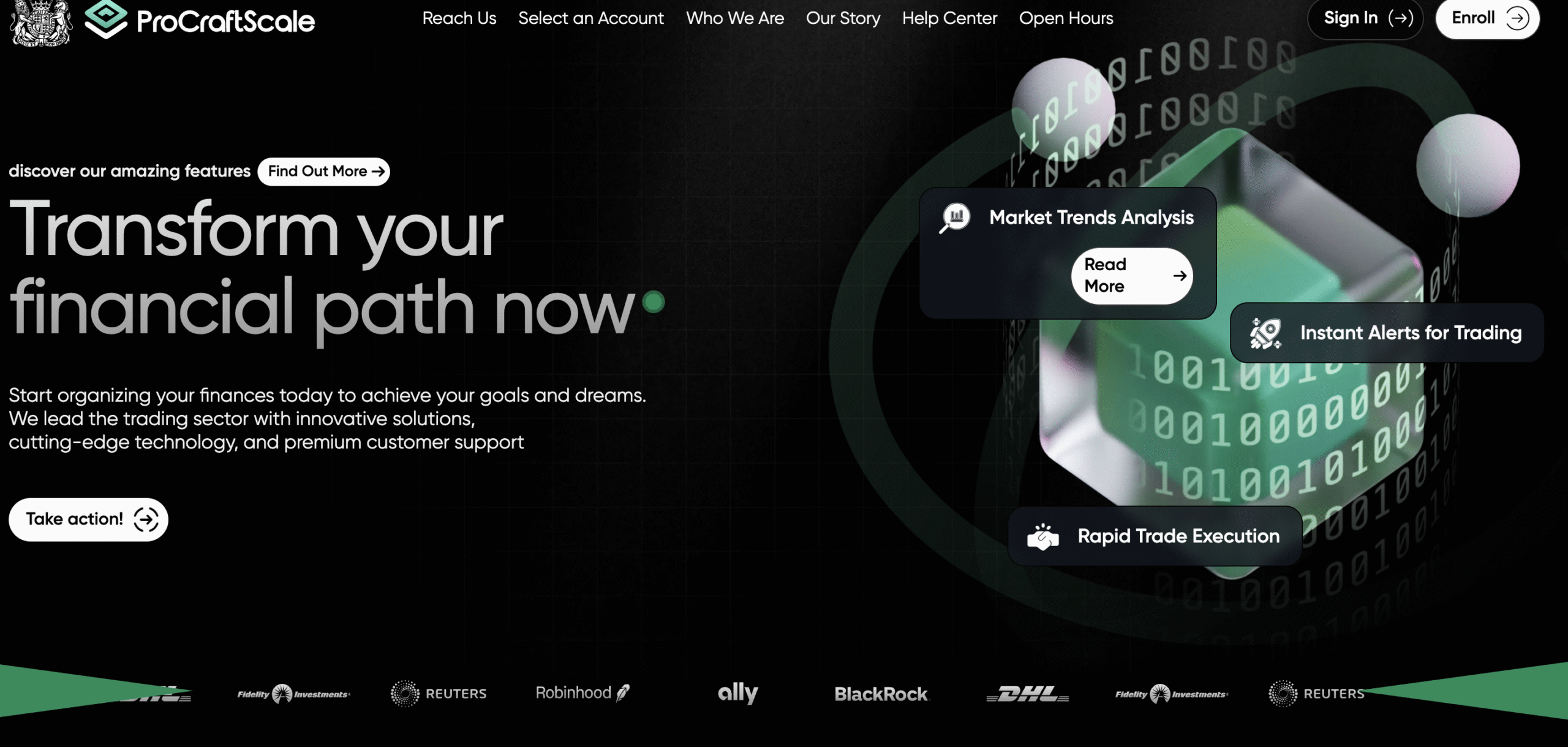DeliveryTradeHub.com presents many of the classic red flags associated with online investment and withdrawal scams. This exposé unpacks the typical script, the technical and behavioral warning signs, the psychological tactics used on victims, and the lifecycle that scam operations like this typically follow. The account below describes patterns and reported behaviors; readers should interpret these as observations and allegations that warrant caution and independent verification.
1 — Main summary
DeliveryTradeHub.com markets itself as an online trading/financial platform that promises rapid returns and easy access to digital markets. Over a short timespan, it has exhibited several worrying characteristics: a newly created web presence with opaque ownership, promotional methods that rely heavily on direct messaging and social outreach, a polished but potentially simulated user dashboard that appears designed to reassure depositors, and a recurring withdrawal blockage narrative that asks users for additional payments to “unlock” funds.
Taken together, these characteristics form a familiar fraud pattern. The aim of this article is not to litigate specifics in court, but to present a clear, detailed view of how this type of operation typically works — and why each element should raise alarm bells.
2 — How the operation presents itself (the public face)
On first contact, DeliveryTradeHub.com is positioned like many modern fintech or crypto startups: slick landing pages, promotional copy promising high percentage returns, and imagery that suggests legitimacy (screenshots of dashboards, corporate-styled logos, and testimonials). The site presents a conversion funnel: entice with high returns, encourage registration, prompt a first deposit (often small to build confidence), then nudge toward larger deposits.
A few features are notable:
-
Polished UI: The site appears professionally designed with a dashboard-like interface that shows balances, “trading results,” and transaction history.
-
Urgent offers: Limited-time bonuses, purported “vip” rates, or invitations to exclusive trading rooms create urgency.
-
Social proof: Fabricated testimonials, screenshots of payments, and claims of large customer bases are used to build perceived legitimacy.
-
Minimal corporate disclosure: Public-facing details such as verifiable company registration, audited reports, or in-depth team bios are thin or absent — an important point we’ll return to.
This public-facing grooming is effective: visual reassurance + implied scarcity = trust-building among less-skeptical prospects.
3 — The recruitment channels: where victims hear about it
Operations like DeliveryTradeHub.com typically reach potential victims through a variety of channels designed to appear organic while actually being high-volume outreach:
-
Direct messages on social platforms and messaging apps: WhatsApp, Telegram, Instagram DMs and similar private channels are commonly used to initiate contact. The private nature of these channels makes them ideal for one-on-one persuasion and pressure.
-
Dating and social apps: In some patterns, scammers use personal connections (or fake profiles) to introduce investment opportunities to people who would not otherwise search for them.
-
Paid ads and search-engine placements: Short-lived ad campaigns can funnel curious users to the site’s landing pages quickly.
-
Referral incentives: Existing victims are sometimes encouraged to recruit others, turning the fraud into a viral mechanism.
The key behavior across channels is proactive outreach — a hallmark of many fraud networks.
4 — The onboarding and trust-building stage
Once someone expresses interest, the onboarding is engineered to build confidence quickly and reduce doubt:
-
Fast registration: An easy signup process with low friction encourages immediate participation.
-
Demo or fake gains: New users are often shown demo accounts or simulated trading activity that displays impressive returns immediately. This is sometimes accompanied by staged “successful withdrawals” to prove the water is fine.
-
Small initial deposit: The platform may accept a small payment first. If that small deposit proceeds smoothly and appears to grow instantly, trust is cemented.
-
Friendly, personal follow-up: A supposed account manager or “relationship officer” reaches out, often using personal language and a degree of intimacy that lowers skepticism.
This mix of quick wins and personal attention is intentionally designed to lull victims into a sense of security.
5 — The withdrawal problem and the advance-fee script
Where many victims become trapped is at the point of withdrawal. The reported pattern — a classic advance-fee style scenario — typically unfolds like this:
-
Request to withdraw: The user initiates a withdrawal after seeing a balance or stated gains.
-
Roadblock introduced: The platform responds that the withdrawal cannot be processed without an additional payment. The explanation varies: “processing energy fee,” “taxes,” “compliance charge,” or “insurance deposit.”
-
Escalating demands: After the first payment, further fees or new reasons are introduced (e.g., an unexpected regulatory hold, additional conversion charges). Each payment is justified with a new pretext.
-
Pressure and urgency: Victims are exhorted to pay immediately, often with threats (loss of bonuses, canceled account) or promises that payment will release the full balance.
-
Cut-off and disappearance: When payments stop, access can be restricted and communications cease. The site may change domain or remove evidence.
This is the operational core of the scam: create a believable, working-looking system, let users fund it, and then invent obstacles that require more funds to overcome.
6 — The technical and operational red flags
A number of technical indicators commonly accompany these operations. Individually, one indicator might be explainable; in combination they form a pattern strongly suggestive of fraudulent intent.
-
New or transient domain registration: Scam sites often launch rapidly and may use privacy-protected registration, making ownership opaque and hard to pursue.
-
Concealed corporate information: Lack of verifiable corporate registration, no audited accounts, and ambiguous office addresses.
-
Inconsistent contact channels: No verifiable telephone numbers or public regulatory registration; communication is routed through private messaging apps or generic email accounts.
-
Simulated systems: Interfaces that display fabricated trading history or mock transactions rather than verifiable, third-party ledger entries.
-
Frequent domain changes: When a domain becomes problematic, operators often move to a new domain to avoid detection and keep the operation alive.
These are technical warning signs — important because they make recourse and accountability difficult.
7 — Psychological tactics DeliveryTradeHub.com use
Scammers are adept at social engineering. Here are the psychological levers commonly used:
-
Reciprocity: Small, early “wins” (an apparent small successful withdrawal or bonus) create a felt obligation to engage further and to reciprocate trust.
-
Scarcity and authority: Limited offers, exclusive invites, and fake endorsements create the illusion that this opportunity is rare and sanctioned.
-
Affinity fraud: Contact through dating apps or social groups exploits personal connection and lowers a target’s guard.
-
Incremental investment: By starting small and slowly encouraging larger sums, perpetrators avoid triggering early suspicion in victims, who rationalize escalations.
-
Isolation and secrecy: Victims are often told not to discuss the opportunity publicly or with family — a technique to prevent external reality checks.
Understanding these tactics helps explain why otherwise skeptical people fall victim.
8 — The lifecycle of this kind of operation
Fraud platforms typically follow a lifecycle designed to maximize intake and minimize exposure:
-
Launch and recruitment: New landing pages, ad campaigns, and mass outreach begin to generate deposits.
-
Build trust: Demo dashboards and staged withdrawals cultivate confidence.
-
Monetize via fees: Withdrawal obstacles and add-on fees are introduced once sufficient funds are onboarded.
-
Cash-out and exfiltration: Operators funnel funds to crypto wallets or international payment rails, often obfuscating the trail.
-
Domain rotation and rebrand: When scrutiny intensifies, the operation either shuts down and reappears under a new name, or disappears entirely, making reclamation difficult.
-
Repeat: The cycle restarts with a new brand or site, often reusing the same techniques.
This lifecycle explains why such operations persist: they are low-cost to set up, high-reward when successful, and disposable when compromised.
9 — Why many victims don’t report immediately (the human cost)
The emotional reality behind scams is important. Victims often delay reporting for several reasons:
-
Shame and embarrassment: People may feel foolish and blame themselves for being deceived.
-
Hope of recovery: Ongoing contact by the perpetrators, combined with promises that paying just one more fee will release funds, encourages continued engagement rather than reporting.
-
Distrust of authorities: Some victims think nothing can be done, especially when payments were made in crypto or to offshore accounts.
-
Social pressure: When a scam began as a recommendation from someone in a social circle, victims may fear social consequence or disbelief.
This human dimension explains why scams proliferate: loneliness and shame work in favor of fraudsters.
10 — Patterns in payments and money flows
While every case varies, there are common monetary patterns:
-
Initial deposits are often small and paid via bank transfer, e-wallets, or cryptocurrency.
-
Subsequent “unlock” fees are requested through less reversible channels (crypto, wire transfers, prepaid vouchers).
-
Funds are moved quickly across multiple wallets and exchanges to obscure the trail, sometimes into jurisdictions with weak regulatory cooperation.
-
Operators favor methods that are difficult or impossible to reverse once completed.
These patterns are engineered to maximize the likelihood that stolen funds cannot be recovered.
Report DeliveryTradeHub.com Scam and Recover Your Funds
If you have lost money to DeliveryTradeHub.com, it’s important to take action immediately. Report the scam to LOSTFUNDSRECOBERY.COM, a trusted platform that assists victims in recovering their stolen funds. The sooner you act, the better your chances of reclaiming your money and holding these fraudsters accountable.
Scam brokers like DeliveryTradeHub.com continue to target unsuspecting investors. Stay informed, avoid unregulated platforms, and report scams to protect yourself and others from financial fraud. Read More reviews at Scams2Avoid
Stay smart. Stay safe.



